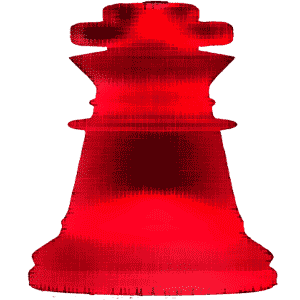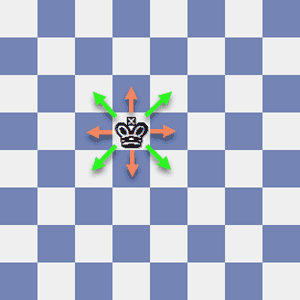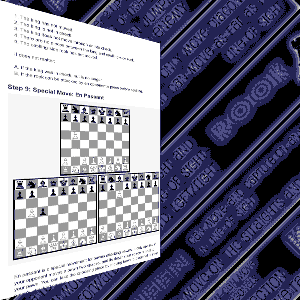Learn The King Moves For Chess

We've finally reached the most important piece in chess. The King moves in an identical fashion to the Queen, but with one major difference.
The King is the central piece in the chess, around whom all of the drama plays out. This is because the object of the game is to capture the enemy King. That is how to win.
So everything you do must be a plan or a sub-plan to first fortify your own King, then to prepare a platform from which to launch a successful attack on the opposing King.
Initial Setup
































































King Moves - Kings start on the home ranks of the e-file
The King and Queen start on the two central squares on their respective home ranks. The Queen is on her own color. This leaves e1 for the White King and e8 for the Black King as they start on squares opposite their colour.
The easiest way to remember is to keep in your mind the old maxim Queen on her color. That means that the White Queen always starts on d1 which is a light square. The Black Queen always begins the game on d8 which is a dark square.
Then just place the King on the remaining square. Remember the corner square nearest to your right hand must be a light square. This square is h1 for White and a8 for Black.
Same Move as Queen but Opposite

King Moves - The King can move in any direction, straight or diagonal, but only one square at a time
Just like the Queen, the King can move straight in any direction or diagonally in any direction. The Queen has maximum range and can move to one side of the board to the other in one move provided her path isn't blocked.
But the King can only move one square at a time, he has minimum range. Because of this lack of mobility the King usually tends to spend much of the game tucked away in a corner where the enemy has difficulty reaching him.
In the endgame when many of the pieces have left the board, the King can take a more active role in the battle. Now it is safer for him in the open when he does not face the imminent threat of checkmate.
Staying Out of Check
































































King Moves - Black has just played ...Nb3# to win the game
Every time you complete a move, you must ensure that your King is not in check. Otherwise the move is illegal. The King can't move to any square under enemy control. Even if that piece is pinned to his own King.
Nor can he cross any square controlled by an enemy in the castling move discussed below. When your opponent attacks your King he puts your King in check. You must rectify this immediately, either by moving your King to a safe square, blocking the check or capturing the checking piece.
If it's not possible for your King to escape the check by one of these three ways then it's checkmate. Your King has been captured and you lose the game immediately.
In the diagram the Knight is attacking the White King. Usually the Knight wouldn't be able to move due to being pinned, but since in theory the next move would be to capture the White King, it's good. All of White's pieces are pinned and the White King has no flight squares to escape the Knight's attack so it's checkmate and Black wins the game.
In the diagram the Knight is attacking the White King. Usually the Knight wouldn't be able to move due to being pinned, but since in theory the next move would be to capture the White King, it's good. All of White's pieces are pinned and the White King has no flight squares to escape the Knight's attack so it's checkmate and Black wins the game.
King of the Castle
































































King Moves - The King and Rook can perform a special castling move once in the game
One of the early objectives in the game is to get the King safe from the opposing forces. This means he should be quickly moved from his precarious starting central position to the relative safety in one of the corners. A special castling move is designed specifically for this purpose.
First off there are a few things to clear up on this. A King can be castled to either side, short to the Kingside or long to the Queenside. The King moves two squares to his right or left and the relevant Rook is moved one square past the King toward the center.
There are a few things that need to be satisfied to make castling legal. You can only castle if the both the King and the Rook involved have not yet been moved. There must be no other piece positioned between Rook and King. The King cannot be in check when the maneuver takes place or obviously upon it's completion. Finally no square that the King crosses when castling can be under attack from an enemy piece. In the diagram White has castled long and Black has castled short.
Moving On

Now you know how all the pieces move. Play through the demos loaded in the King Tutorial. Well that was the easy bit. From here the road will get more and more interesting.
Now that you can move the pieces there is just one question. How do you get the most out of them and exploit their potential? I can take you through some fundamental strategic basics, giving you a good base to start from.
Let's face it, even if the general movements are easy enough, there are a few things to remember with respect to promotions, en passant and castling. No rush, if you're not completely sure of anything, just take another look at basic chess rules.

